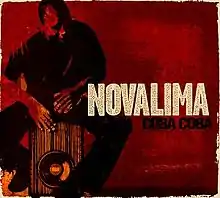Coba Coba
Coba Coba is the third album from the Peruvian band, Novalima. The 2009 release, off U.S.-based, independent label, Cumbancha further explores Afro-Peruvian music's African roots.[Notes 1] The band implores the use of various genres, reggae, dub, salsa, afro-beat, to create their sound.[1] Coba Coba stays true to its traditional roots while simultaneously pushing the boundaries; "Most people still think Peru is only panpipes," says guitarist/keyboardist Rafael Morales. "This is our interpretation of traditional Afro-Peruvian music, forward-thinking but without losing the soul and tribal rhythms of its roots."[Notes 2] The sound is cutting edge but traces its roots back to the times of Spanish Colonial rule and slavery.[Notes 1]
| Coba Coba | ||||
|---|---|---|---|---|
 | ||||
| Studio album by | ||||
| Released | January 13, 2009 US | |||
| Recorded | 2005-2008 | |||
| Genre | World, reggae, dub, hip hop, Afrobeat | |||
| Label | Cumbancha | |||
| Producer | Toni Economides | |||
| Novalima chronology | ||||
| ||||
Critical reception
Coba Coba was nominated for a 2009 Latin Grammy Award for Best Alternative Album.[2] Neil Spencer of The Guardian called the album "a polished fusion borrowing freely from folk, salsa, highbrow poetry, and ghetto dancefloor."[3] Allmusic's Jeff Tamarkin said that "its more minimalist, harder-edged production and less global-minded reach allow for fewer sonic surprises" than the band's previous album, Afro.[4] Ernest Barteldes of the Houston Press remarked that the fusion of Peruvian music with "elements of electronica, hip-hop, samba, and other genres" results in a sound that is "something fresh that still is closely attached to their roots."[5] Nils Jacobson of PopMatters gave the album a 9 out of 10 rating and wrote: "Elements of funk, reggae, salsa, Afrobeat, hip-hop, and dub mingle freely with traditional landó, marinera, cumanana, and vals criollo—there are no forced combinations—and the guest musicians, mainly horn players and vocalists, add extra flavor."[6]
Track List
| No. | Title | Length |
|---|---|---|
| 1. | "Concheperla" | 4:11 |
| 2. | "Libertá" | 3:40 |
| 3. | "Se Me Van" | 4:37 |
| 4. | "Ruperta/Puede Ser" | 4:04 |
| 5. | "Africa Lando" | 4:18 |
| 6. | "Coba Guarango" | 4:07 |
| 7. | "Camote" | 4:26 |
| 8. | "Mujer Ajena" | 3:51 |
| 9. | "Tumbala" | 4:00 |
| 10. | "Kumaná" | 5:23 |
| 11. | "Yo Voy" | 3:51 |
| 12. | "Bolero" | 3:37 |
References
- Rodríguez Martorell, Carlos (13 January 2009). "Novalima mixes old and new sounds from Peru". New York Daily News. Retrieved 7 June 2014.
- Gilbert, Andrew (10 July 2011). "Afro-Peruvian sound with an electronica beat". Boston Globe. Retrieved 7 June 2014.
- Spencer, Neil (17 January 2009). "Novalima: 'Coba Coba'". The Guardian. Retrieved 7 June 2014.
- Tamarkin, Jeff. "'Coba Coba' Review". Allmusic. Retrieved 7 June 2014.
- Barteldes, Ernest (24 December 2008). "Sonidos y Mas: NovaLima". Houston Press. Retrieved 7 June 2014.
- Spencer, Neil (1 April 2009). "Reviews: Novalima: 'Coba Coba'". PopMatters. Retrieved 7 June 2014.